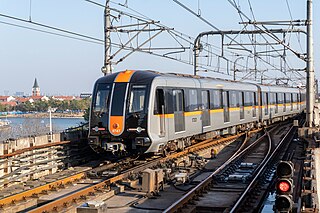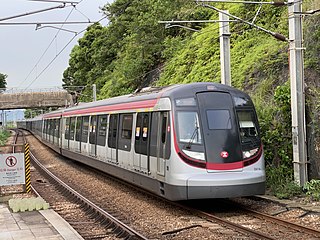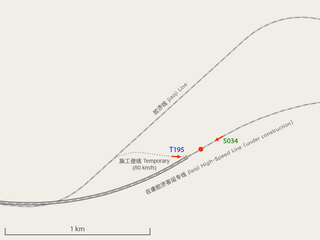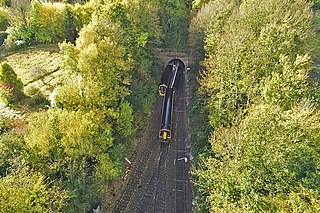The Armagh rail disaster happened on 12 June 1889 near Armagh,County Armagh,in Ireland,when a crowded Sunday school excursion train had to negotiate a steep incline;the steam locomotive was unable to complete the climb and the train stalled. The train crew decided to divide the train and take forward the front portion,leaving the rear portion on the running line. The rear portion was inadequately braked and ran back down the gradient,colliding with a following train.

The Shanghai Metro (Chinese:上海地铁;pinyin:Shànghǎi Dìtiě;Shanghainese:Zaon6he5 Di6thiq7) is a rapid transit system in Shanghai,operating urban and suburban transit services to 14 of its 16 municipal districts and to the neighboring township of Huaqiao,in Kunshan,Jiangsu Province.

The East Rail line is one of the ten lines that form MTR,the mass transit system in Hong Kong. The railway line starts at Lo Wu or Lok Ma Chau,both of which are boundary crossing points into Shenzhen and joins in the north at Sheung Shui and ends at Admiralty station on Hong Kong Island. At approximately 46 km (29 mi),the line is the second longest line within the network,behind the Tuen Ma line. The line's colour is light blue.
There have been a number of train accidents on the railway network of Victoria,Australia. Some of these are listed below.
The railways of New South Wales,Australia have had many incidents and accidents since their formation in 1831. There are close to 1000 names associated with rail-related deaths in NSW on the walls of the Australian Railway Monument in Werris Creek. Those killed were all employees of various NSW railways. The details below include deaths of employees and the general public.

The Zibo train collision was a major train collision that occurred on the morning of April 28,2008,near the city of Zibo,in Shandong province,People's Republic of China. The collision occurred on the Jiaoji Railway,which links the important cities of Qingdao and Jinan in Shandong province. With a death toll of 72 people and 416 injuries,the collision was the deadliest rail accident in the People's Republic of China since a 1997 accident in Hunan.

The Friedewald train collision was a railway accident on 12 September 2009 in Saxony,Germany. It involved two steam-hauled passenger trains of the narrow gauge heritage Radebeul–Radeburg railway. One hundred and twenty-one people were injured,four of them seriously. Substantial damage was sustained by the locomotives and rolling stock.

The Round Oak railway accident happened on 23 August 1858 between Brettell Lane and Round Oak railway stations,on the Oxford,Worcester and Wolverhampton Railway. The breakage of a defective coupling caused seventeen coaches and one brake van,containing about 450 passengers,of an excursion train to run backwards down the steep gradient between the stations,colliding with a following second portion of the excursion. 14 passengers were killed and 50 injured in the disaster. In the words of the Board of Trade accident inspector,Captain H. W. Tyler,it was at the time "decidedly the worst railway accident that has ever occurred in this country".

The Wenzhou train collision was a railway accident that occurred on 23 July 2011,when a high-speed train travelling on the Yong-Tai-Wen railway line collided into the rear of another stationary train on a viaduct in Lucheng District,Wenzhou,Zhejiang province,People's Republic of China. The two trains derailed,and four carriages fell off the viaduct. 40 people were killed,and at least 192 were injured,12 severely. This disaster was caused by both defects in railway signal design and poor management by the railway company.

Fuxing is a series of high-speed and higher-speed EMU trains operated by China Railway High-speed (CRH) and developed by CRRC,which owns the independent intellectual property rights entirely. The Fuxing series do not contain any technology that is patented or licensed by foreign train makers,and demonstrates China's ability to build faster trains through homegrown innovations.
On 3 February 2003,a Comeng electric multiple unit train rolled away from Broadmeadows station in Melbourne,Australia,before it ran for nearly 17 kilometres (11 mi) out of control without a driver and eventually crashed into another train about to depart Spencer Street station. Train controllers attempted several times to stop or redirect the train,but were limited in their ability to intervene,instead being forced to alter the route of other trains to avert a more serious collision. Eleven people on board the stationary train were injured;authorities did not know until after the crash if any passengers were on board the runaway. An investigation identified driver error as the cause of the accident,but the runaway event prompted significant debate about the role of government authorities and private operators in ensuring safety and reliability on the Melbourne rail network.

China Railways 25G rolling stock,or China Railways 25 improved rolling stock is a series of passenger carriages built in China. The carriages run services in mainland China,and on the Trans-Siberian Railway for international services to Moscow. They are also exported to Mombasa–Nairobi Standard Gauge Railway,Addis Ababa–Djibouti Railway,Guinea railways,and Uganda Standard Gauge railways.

On 15 November 1991,two passenger trains collided in Miaoli County,Taiwan,killing 30 people and injuring 112. It was the deadliest train accident in Taiwan since 1948 until April 2021 when 49 passengers were killed after a train derailed in Hualien.

On 2 April 2021,at 09:28 NST (01:28 UTC),a Taroko Express train operated by the Taiwan Railways Administration (TRA) derailed at the north entrance of Qingshui Tunnel in Heren Section,Xiulin Township,Hualien County,Taiwan,killing 49 people and injuring at least 200 others. At the time of the accident,the train was carrying 494 passengers. The eight-carriage train derailed after colliding with a construction truck that had fallen down a slope onto the tracks north of Hualien City;the train came to rest in the tunnel,with severe damage and many casualties. The train incident was primarily due to human factors and was preventable,as an investigation from The New York Times,revealed that it was "systemic failures at a government agency" including "a culture of complacency and weak oversight",that had made the disaster possible.

Chenzhou railway station is a railway station in Beihu District,Chenzhou,Hunan,China. It is an intermediate stop on the Beijing–Guangzhou railway.

The Salisbury Rail Crash was a railway accident on 31 October 2021,at Salisbury,Wiltshire,United Kingdom. Two trains,travelling on converging lines,collided at Salisbury Tunnel Junction,approximately one mile northeast of Salisbury railway station. Fourteen people,including one of the train drivers,were taken to hospital.

The DJF2"Xianfeng" electric multiple unit is a model operated formerly by China Railway with traction motors distributed throughout the unit. It was developed in 2001 as a key task of the science and technology targets of the Ninth Five-Year Plan. It was an innovative and advanced design being the first Chinese multiple unit train to achieve 200 km/h (124 mph) and achieving a top test speed of 292.8 km/h (181.9 mph) in tests,but had numerous flaws in the design that complicated operations.
The TSD09 diesel multiple unit is a tilting train developed by Tangshan Locomotive in 2003 and fitted with Cummins diesel engines,Voith hydraulic transmission and Extel Systems Wedel tilting mechanisms. It was built for Sanmao Railway,but due to strategic reasons within the Ministry of Railways,the set never operated commercially and has been permanently stored at Tangshan Locomotive.













